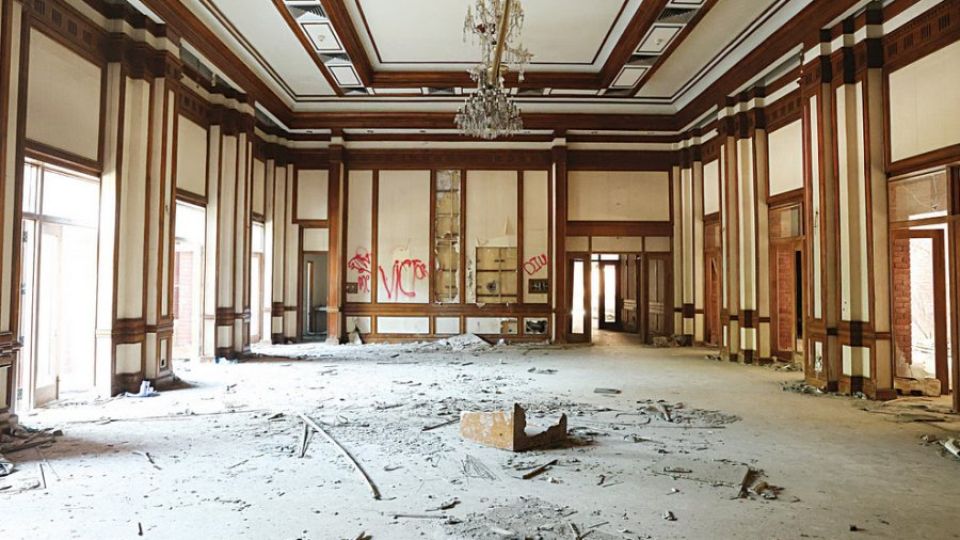February 21, 2025
DHAKA – It took the Ansar members guarding the Gono Bhaban quite a few tries before they could locate the keys and unlock the main gate of what was the most strictly guarded citadel inside the capital until only six months back.
Gone are the days when Special Security Force officers armed with assault rifles used to shoo away pedestrians trying to use the pavement flanking the thick boundary walls of the premises.
Even the ominous brass nameplate at the entrance is gone — hauled away for resale the day of the proverbial storming of the “palace”. A person new in the city would hardly recognise it as having once been the central command centre of an elaborate autocracy.
Upon entering through the gates, the first thing one would see is a pile of damaged, charred vehicles, an emblematic reminder of the public’s intense anger towards Sheikh Hasina.
A massive collection of heavy wood furniture and household items stood collecting dust in front of the entrance of the house like a garage sale gone wrong — all items too large to be taken away on the day taxpayers lay claim on their money’s worth.
The first room inside is a large hall where the former prime minister held her infamous press conferences from where she had rung her regime’s death knell by calling the protesters “razakars”. Only those able to shower her with flowery praises were allowed inside this room. It is mentionable that The Daily Star was not allowed to enter the Gono Bhaban or cover any of her programmes for over a decade, and we were never given an official explanation.
Six months on since her ignominious ouster, the empty walls now harbour graffiti saying things that would have been considered punishable by death if she were still in power.
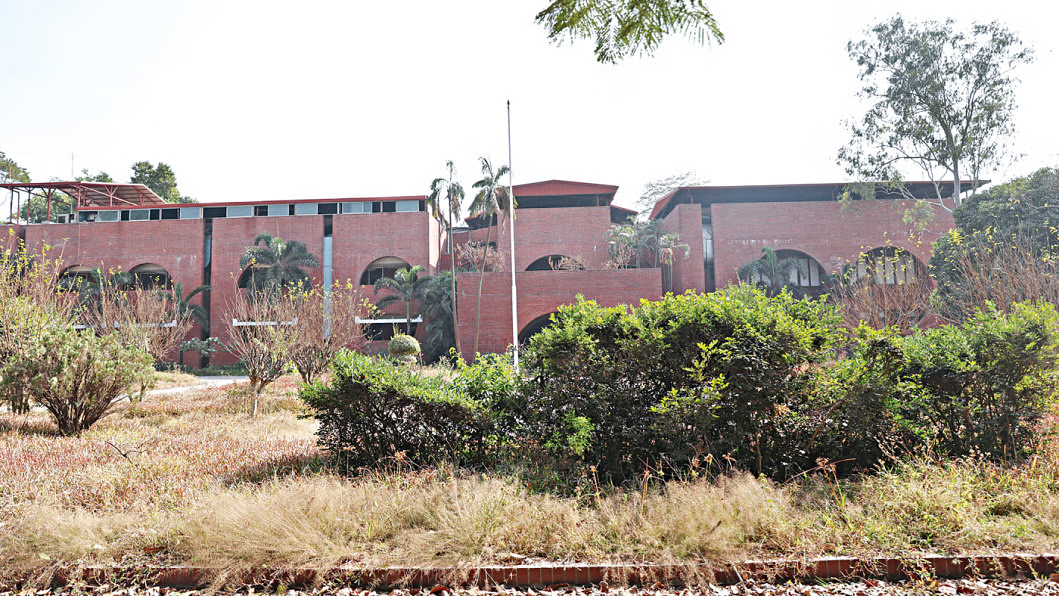
Once a central command of Sheikh Hasina’s brutal dictatorship, the post-August Gono Bhaban, is now all but in ruins. PHOTO: THE DAILY STAR
All quarters used by Hasina had thick bulletproof walls, with reinforced concrete peeking through the spaces where protesters had torn down the plaster. Hasina, who survived multiple assassination attempts, was so paranoid about her safety that her Awami League government even passed the “Father of the Nation Bangabandhu Sheikh Mujibur Rahman’s Family Members Security Act”, a law guaranteeing state-provided protection to her and her extended family. But in the end, it was not a bullet that ended her tenure.
The labyrinthine corridors of the massive house now are a pitch-black trip hazard, while the broken glass now carpeting the floors crunch with each step. In many of the rooms, the ceilings still carry empty chandelier holders, but the broken windows provide respite, allowing sunlight to stream in. As dusk falls, the house goes dark.
Although the 2.75-acre Gono Bhaban is quite literally named “People’s Residence,” none of Bangladesh’s premiers except Hasina has ever lived in it, since its construction in 1973 by her father Sheikh Mujib.
Khaleda Zia, Ziaur Rahman, and HM Ershad all used their cantonment residences while serving at the country’s helm.
Infamously, Hasina had leased it for Tk 1 (yes, Tk one) in 2001, just a few days before the end of her government’s tenure as part of the now-repealed “The Father of the Nation’s Family-Members Security Act”. Hasina stayed there even after her tenure had ended and former chief justice Latifur Rahman-led caretaker government had assumed office on July 15, 2001. She only left Gono Bhaban on August 16, 2001, following huge political pressure from the opposition camp. At the time, she repeatedly claimed that her utility connections were cut off.
Amid the thick layer of dust, animal faeces and broken glass carpeting the floors lies scores of crumpled-up documents that offer a rare glimpse into the life and mind of the person who had turned the country into a mindless dictatorship.
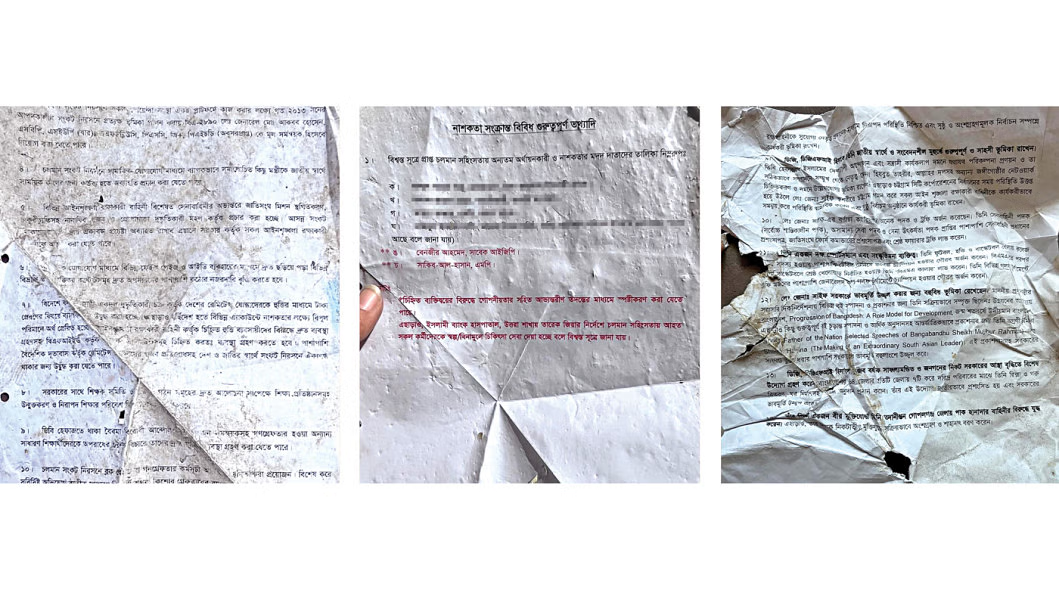
Some documents that offer, among other things, insights into how her government sought to keep citizens under surveillance. PHOTO: THE DAILY STAR
During her last days inside the house, Hasina was concocting ways to thwart the July uprising, according to documents found in the house during our visit on February 8.
An intelligence agency document found in her bedroom contains an 11-point action plan to counter the movement against her 15-year regime.
Point number nine of that action plan recommended quickly sentencing the protesting students and student coordinators under the speedy trial act.
“Take quick legal action against the Anti-discrimination Student Movement activists in DB (detective branch) custody and the general students detained in mass-arrests in the speedy trial tribunals, depending on the severity of the offences,” said one point.
The recommendation makes it evident that the document was from the last week of July, when six student coordinators, including Nahid Islam and Asif Mahmud were in DB custody.
“In order to control the ongoing law and order situation, some ministers may be temporarily relieved from their duties,” recommended the document.
The document also recommended the appointment of Lt Gen (retd.) Md Akbar Hossain, former director general of Directorate General Forces Intelligence, as a coordinator to handle the whole crisis.
There is currently an arrest warrant for Akbar, issued by the International Crimes Tribunal (ICT) on January 6, 2024.
The document also recommended the government to step up “strict surveillance” and remove and block “objectionable” content being spread by different pages and profiles.
It also recommended the former PM to instruct Bangladesh Financial Intelligence Unit to crack down on hundi networks that were being used to finance the movement.
Another document found crumbled under the debris contained a list of six people who were identified for Hasina as being “financiers and instigators”. The list contained the names of two bank heads, one businessman, and one man who was said to be “a close associate of Tarique Zia and a friend of additional inspector general of police (IGP) Monirul Islam”. Monirul, now said to have fled the country, also headed the Special Branch of the police, which is the police’s intelligence agency.
The document also contained two surprising names — former police chief Benazir Ahmed and cricket superstar and former AL lawmaker Shakib Al Hasan. The document recommended a covert investigation against the two.
The document also pointed out that Islami Bank Hospital’s Uttara Branch was giving free treatment to all the injured “upon the orders from Tarique Zia”.
In one corner of Hasina’s bedroom, The Daily Star found a page about what Islam says against killing people.
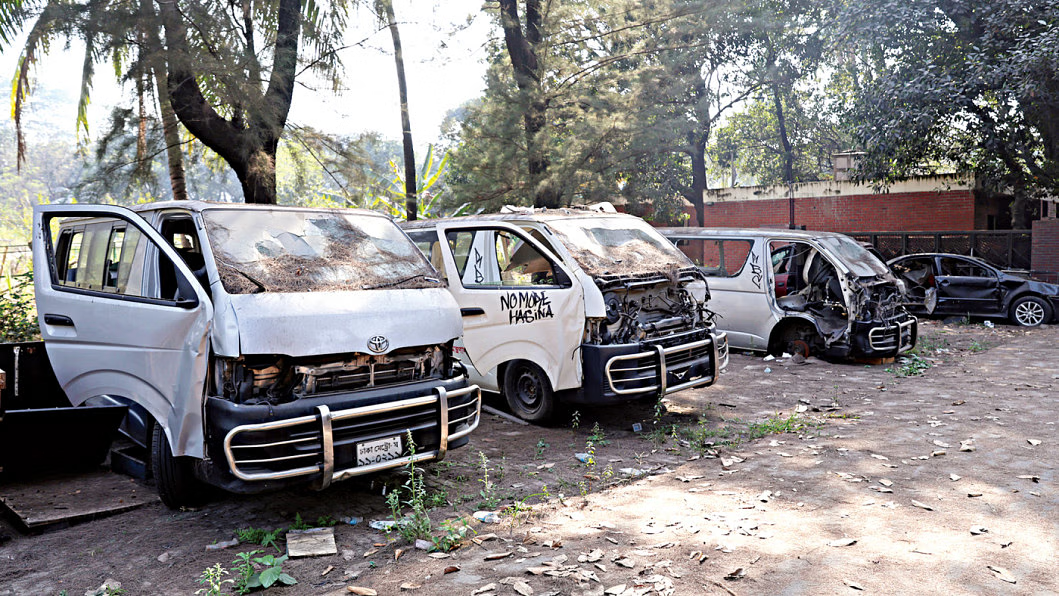
Charred vehicles in the compound. PHOTO: THE DAILY STAR
A line in the page read: “If a person takes one life, it is as if he has killed everybody.”. Another line stated, “The Prophet (pbuh) described killing humans as the worst crime, and called it a “kabira” (cardinal) sin. He said, ‘To Allah, the destruction of the whole universe pales in comparison to the murder of one believer.'”
It is an irony that so many people were killed — at least 1,400 — on her watch during the uprising, the UN Fact Finding Report says citing testimonies of some of her inner circle.
Another document extracted from the floor contains a list of donations made by different Awami League lawmakers to the party fund.
Former railways minister Zillul Hakim topped the list, transferring Tk 50 lakh to the party fund on March 21, 2015. Former lawmaker Md Qamrul Islam gave Tk 20 lakh in the same year. Former land minister Saifuzzaman Chowdhury Javed gave Tk 1.42 lakh on January 11, 2018.
The second page shows how 28 reserved-seat lawmakers together gave Tk 2.44 crore to the AL coffers.
A torn page from what appeared to be a gift register showed Hasina receiving two luxury pens, two decorative tumblers, and a decorative storage box during her Japan visit in 2016.
On the ground floor, a room — the in-house medical centre — was littered with pill cases and tablet-strips.
Among the heaps of documents lying on the floor, two Covid-antibody test results stood out: the patient’s name field read “Sheikh Hasina, Hon’ble Prime Minister, People’s Republic of Bangladesh”. The antibody results dated February 1 and August 18, 2023, stated that Hasina tested positive for Covid twice.
The documents littering her rooms entangled with beige socks and hairties left behind revealed one other thing – the extent to which Hasina kept the common citizens under surveillance.
In the aftermath of the storming of the Gono Bhaban, people found that she had been tapping the phones of influential members of society, the transcripts of which were found in her bedroom. Others found that she had been maintaining a logbook of members of the armed forces who were politically different from her.
Her rooms still contain pages upon pages of reports on her party members, and government employees (including a glowing report of a former intelligence agency chief who is currently being prosecuted by the ICT). A full list of the candidates that passed the written tests of the 32th Bangladesh Civil Service exams was found, along with the admit cards of many candidates.
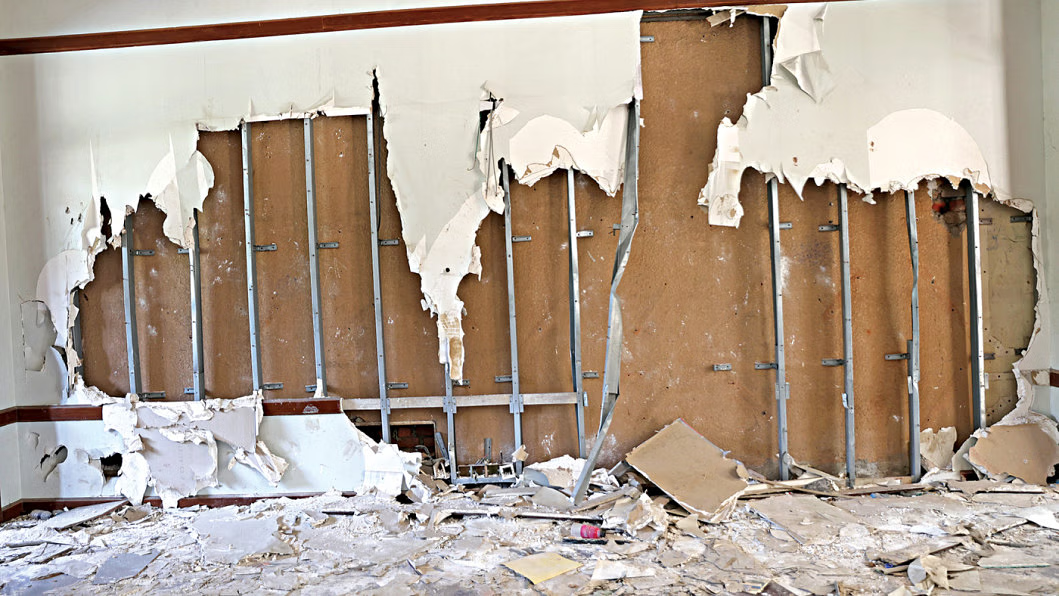
A crumbling wall inside the palace. PHOTO: THE DAILY STAR
Various documents scattered around the Gono Bhaban premises bear testimony that Hasina’s surveillance using the state apparatus was pervasive – state bodies, private organisation, cultural activists, even private citizens were all being watched by the “Big Sister”.
Even her own party colleagues were not outside the massive cobweb of surveillance.
Several documents were seen containing area-wise descriptions of infighting within the party, and constituency-wise briefs about the popularity of her party candidates. Many documents were seen containing allegations against her party’s grassroots leaders. An official letterhead of Bangladesh Supreme Party containing a list of the 10 candidates provided by the party for 2024 dummy election was also spotted.
The torn pages on the floor make it evident that other than party activities, Hasina’s interests mostly swung in two directions — her father, and BNP.
She was obsessed with her father. Her rooms still hold heaps of pages of manuscripts of films, plays and books about her father, as well as printouts of diplomatic cables and telegrams from 1971 lying entangled with pairs of synthetic beige socks.
On the other hand, her quarters housed a myriad of documentation about BNP.
An intelligence agency report found in the trash on the floor briefed Hasina about the three-day blockade programme that was called by the BNP from October 31, 2023, and recommended possible steps that the government could take.
The report recommended beefing up surveillance in areas dominated by BNP and Jamaat. It suggested that the government conduct drives to search their homes and establishments, and arrest and round up members with cases against them.
It also urged the government to establish police checkpoints in Dhaka city’s entry points and establish full control of all going in and out.
“BNP wants a ‘dead body’ to make this movement successful, so they might try to kill one of their activists,” said the report.
The report added that Western diplomatic channels in Bangladesh were trying to convince Jatiya Party’s GM Quader to join BNP’s movement.
It also said that BNP was conveying false statements to the United Nations, international human rights organisations and the different Western embassies in the capital about the situation of the country to get their “sympathy”.
Hasina’s collection also included meticulous documentation of oppression and abuse faced by religious minorities and her party’s men during 2003-2006 when BNP was in power, with details of individual cases. We also found a letter from the wife of 30-year-old truck driver named Mehedi Hasan from Faridpur who had suffered 64 percent burn injuries and perished later when blockaders set fire to his truck in 2013. Hasina also collected photos of victims who suffered burn injuries during that blockade.
Just as Hasina’s reading habits gave a glimpse into her mind, the documents left behind in the other rooms of the living quarters offer a peek into who the inhabitants might have been.
Her daughter Saima Wazed Putul, her son Sajeeb Wazed Joy and her nephew Radwan Mujib Siddiq Bobby all seemingly stayed with Hasina, at times, and also shared their rooms with Hasina’s grandchildren.
All three rooms had one wall painted in different colour – pink, blue and yellow – and each had a hand-painted tree with birds.
The room with the pink walls had piles of documents about autism, Putul’s area of expertise. A discarded box of a Lego set for girls lay in the mess, while the bathroom still had some female toiletries like a broken pink razor. Tellingly, a large Chanel gift box lay flattened on the floor.
In the next room with the blue wall, Joy’s business cards lay on the floor next to a crumpled blue shirt from Hugo Boss. The documents in the room contained laws and regulations about tower companies, project papers about expanding fibre optic connections and statements of stock market transactions at the New York Stock Exchange. The stock statements from 2010 were signed and attested by the Bangladeshi embassy in the US, and are in the name of a man called Mohammed Aminul Hoque.
Joy’s pet project, mobile financial services Nagad, was led by a man with the same name. Bangladesh Bank filed a Tk 645 crore embezzlement case against him and others on February 5.
His reading materials also included a report by the Sampadak Parishad criticising the Digital Security Act.
Radwan Mujib’s business cards were found in the adjacent room. This room contained meeting minutes of Centre for Research and Information (CRI), AL’s research wing. The yellow wall in the room was sprayed with graffiti saying “Victory to Democracy 2024”. A photo card containing Tulip Siddiq’s annual report for 2022 was seen on the second floor.
The residential quarters opened into a large living room for the family. A broken children’s slide lay on the floor outside the living room. An ornate sofa lies torn and battered — its pillows were taken away by protesters on August 5. Heaps of newspapers from July litter the ground, with the most recent one dating back to August 3, 2024, two days before Hasina fled to India. The family read The Daily Sun, Financial Express, Jugantor, Janakantha, Bonik Barta, The Daily Ittefaq and Naya Diganta.
The balcony of the living room still holds planters, their inhabitants shrivelled and dead from six months of neglect.
But outside, as spring creeps in, the grounds are thriving. The moat surrounding two sides of the premises from where Hasina often caught massive catfishes may no longer have its larger residents but the lake is very much alive with aquatic fauna awaiting the first rain of the season.
As the lawnmowers lie broken and discarded to a side, the grass grows knee-high. The flowering shrubs — ixora, bougainvillea and yellow elder — are a riot of colour, without having received a drop of water since Gono Bhaban’s army of gardeners fled on August 5. The large Krishnachura (Poinciana) tree that had stood sentry beside the gate, which now lies battered on the ground, is bursting with new leaves. Green and blue-tailed parrots reign supreme.


